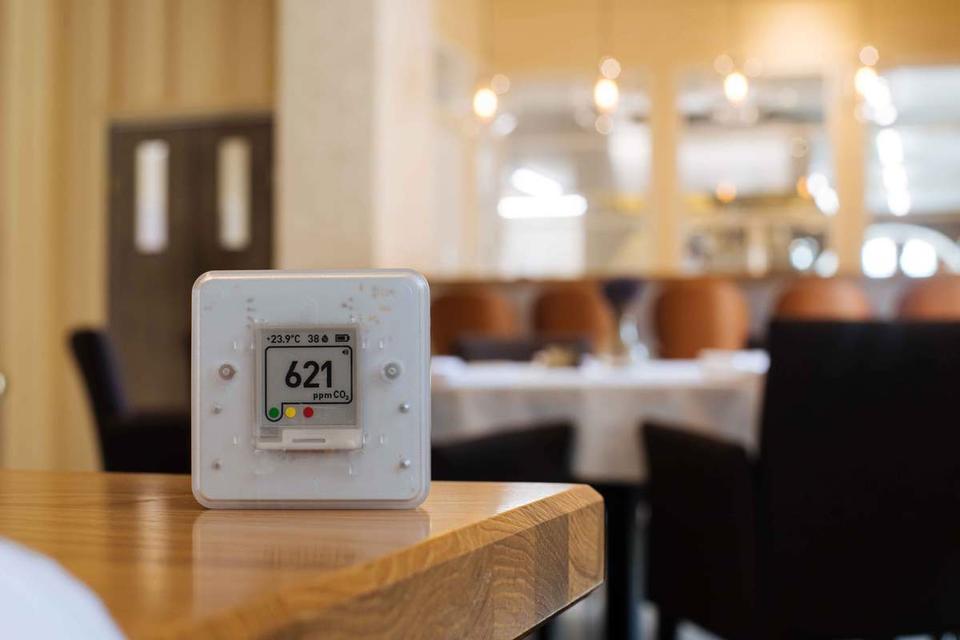
Carbon dioxide (CO2) monitors are useful for assessing a building’s ventilation, but their readings can mean different things in different buildings. A new online resource from NIST could help building professionals understand whether CO2 levels indicate poor or adequate ventilation in their particular space.
A key ingredient for good indoor air quality is good ventilation. One simple method that can be used to determine if a space is well ventilated is to measure indoor carbon dioxide (CO2) levels.
This greenhouse gas drifts through more than just our skies. CO2 can be found in the buildings where we live, work and shop too, as it is part of the air we breathe out. Good ventilation will keep the concentrations of CO2 and an array of contaminants low. Poor ventilation will allow them to accumulate. How do you know which category your ventilation fits into?
A new online tool developed by researchers at the National Institute of Standards and Technology (NIST) offers answers. The free tool calculates target CO2 levels based on the user’s desired ventilation rate and information about a building and its occupants. In many buildings, ventilation is often misunderstood or infrequently assessed, but with NIST’s new resource, building professionals can use CO2 readings to routinely check ventilation, detecting potentially unfavorable conditions that could lead to the buildup of harmful contaminants.
The approach of using CO2 to properly gauge ventilation and the tool, named Quick Indoor CO2 (QICO2), are described in a new paper published in the journal Indoor Air.
“By measuring CO2, you can verify that you’re achieving the ventilation rate that your space was designed for, but you need to consider all the factors that impact CO2 levels,” said NIST Fellow Andrew Persily, author of the new paper.
While the direct impact that indoor CO2 has on health is unclear, its concentration can serve as an indicator of a building’s ventilation rate, which, if adequate, can reduce the concentration of many important indoor contaminants. And where many contaminants are challenging to detect directly, CO2, despite being imperceptible to our senses, can easily be tracked with widely available CO2 monitors.
CO2 monitoring technology rose in popularity during the COVID-19 pandemic, as federal and industry experts recommended improving ventilation along with using other measures such as masks and air filters, which do not capture CO2 but can ensnare infectious aerosols. For establishing good ventilation, however, monitoring is only half the battle.
“With the pandemic, many restaurants and other kinds of businesses started putting CO2 monitors on the wall. But what do those numbers they are showing mean?” Persily said.
A CO2 level of 1,000 parts per million (ppm) or higher is commonly seen as a signifier of poor indoor air quality. But this rule of thumb could be misleading. Important factors that influence indoor CO2 differ from building to building, so while 1,000 ppm or lower may translate to adequate ventilation in some spaces, it could be inappropriate for others.
“Finding the CO2 level that corresponds to one’s desired ventilation rate is a matter of collecting the relevant information and doing some math,” Persily said.
The number of occupants and their age, weight and level of physical activity are all variables that directly drive the amount of CO2 indoors. The outdoor CO2 levels and a building’s size and indoor temperature play important roles too. Persily pulled together the mathematical relationships between these factors and indoor CO2 levels, packaging them together within QICO2.
The computer program serves as a CO2 calculator. The user can manually enter the pertinent information or choose from a list of predefined scenarios that describe schools, residences and commercial buildings, many of which are covered by a ventilation standard issued by the American Society of Heating, Refrigerating and Air-Conditioning Engineers (ASHRAE). Then QICO2 does the math to come up with CO2 levels users can compare their real-world readings against and take actions to correct their ventilation system if needed.
By leaving ventilation unchecked or assessing it with arbitrary CO2 values, building professionals could be leaving room for poor indoor air quality to go undetected.
“The danger is that you may miss something that really matters. And you might think things are bad when they really aren’t, or perhaps even worse, you might think the air is fine when it’s not,” Persily said.
With QICO2, which is freely available on NIST’s website, building professionals can evaluate their current approach to judging ventilation by checking it more regularly and more meaningfully to help keep indoor air clean.
Paper: Andrew Persily. Development and Application of an Indoor Carbon Dioxide Metric. Indoor Air. Published online July 19, 2022. DOI: 10.1111/ina.13059

